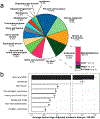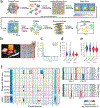Precision Medicine in Pediatric Neurooncology: A Review
- PMID: 29199818
- PMCID: PMC6656379
- DOI: 10.1021/acschemneuro.7b00388
Precision Medicine in Pediatric Neurooncology: A Review
Abstract
Central nervous system tumors are the leading cause of cancer related death in children. Despite much progress in the field of pediatric neurooncology, modern combination treatment regimens often result in significant late effects, such as neurocognitive deficits, endocrine dysfunction, secondary malignancies, and a host of other chronic health problems. Precision medicine strategies applied to pediatric neurooncology target specific characteristics of individual patients' tumors to achieve maximal killing of neoplastic cells while minimizing unwanted adverse effects. Here, we review emerging trends and the current literature that have guided the development of new molecularly based classification schemas, promising diagnostic techniques, targeted therapies, and delivery platforms for the treatment of pediatric central nervous system tumors.
Keywords: Precision medicine; neurooncology; pediatrics; review.
Figures





Similar articles
-
New Classification for Central Nervous System Tumors: Implications for Diagnosis and Therapy.Am Soc Clin Oncol Educ Book. 2017;37:753-763. doi: 10.1200/EDBK_175088. Am Soc Clin Oncol Educ Book. 2017. PMID: 28561665 Review.
-
Precision Medicine for Primary Central Nervous System Tumors: Are We There Yet?Am Soc Clin Oncol Educ Book. 2018 May 23;38:158-167. doi: 10.1200/EDBK_199247. Am Soc Clin Oncol Educ Book. 2018. PMID: 30231322 Review.
-
Pediatric Ependymoma.J Child Neurol. 2016 Oct;31(12):1354-66. doi: 10.1177/0883073815610428. Epub 2015 Oct 26. J Child Neurol. 2016. PMID: 26503805 Review.
-
Central nervous system tumors.Pediatr Clin North Am. 2008 Feb;55(1):121-45, xi. doi: 10.1016/j.pcl.2007.10.010. Pediatr Clin North Am. 2008. PMID: 18242318 Review.
-
Advances in the management of pediatric central nervous system tumors.Ann N Y Acad Sci. 2008 Sep;1138:22-31. doi: 10.1196/annals.1414.005. Ann N Y Acad Sci. 2008. PMID: 18837879 Review.
Cited by
-
Indisulam Reduces Viability and Regulates Apoptotic Gene Expression in Pediatric High-Grade Glioma Cells.Biomedicines. 2022 Dec 27;11(1):68. doi: 10.3390/biomedicines11010068. Biomedicines. 2022. PMID: 36672576 Free PMC article.
-
The peculiar challenge of bringing CAR-T cells into the brain: Perspectives in the clinical application to the treatment of pediatric central nervous system tumors.Front Immunol. 2023 Mar 21;14:1142597. doi: 10.3389/fimmu.2023.1142597. eCollection 2023. Front Immunol. 2023. PMID: 37025994 Free PMC article. Review.
-
Effects of the surface polarity of nanomaterials on their interaction with complement protein gC1q.RSC Adv. 2020 Nov 18;10(69):41993-42000. doi: 10.1039/d0ra05493c. eCollection 2020 Nov 17. RSC Adv. 2020. PMID: 35516759 Free PMC article.
-
Nanomedicine for Spontaneous Brain Tumors: A Companion Clinical Trial.ACS Nano. 2019 Mar 26;13(3):2858-2869. doi: 10.1021/acsnano.8b04406. Epub 2019 Feb 4. ACS Nano. 2019. PMID: 30714717 Free PMC article.
-
The Molecular Basis of Pediatric Brain Tumors: A Review with Clinical Implications.Cancers (Basel). 2025 May 4;17(9):1566. doi: 10.3390/cancers17091566. Cancers (Basel). 2025. PMID: 40361492 Free PMC article. Review.
References
-
- Linabery AM, and Ross JA (2008) Trends in childhood cancer incidence in the U.S. (1992–2004). Cancer 112, 416–432. - PubMed
-
- Weil AG, Wang AC, Westwick HJ, Ibrahim GM, Ariani RT, Crevier L, Perreault S, Davidson T, Tseng CH, and Fallah A (2017) Survival in pediatric medulloblastoma: a population-based observational study to improve prognostication. J. Neuro-Oncol 132, 99–107. - PubMed
Publication types
MeSH terms
Grants and funding
LinkOut - more resources
Full Text Sources
Other Literature Sources

